NORTH SEA
REPORT
North Sea activity remains sound
Continued
strong prices are attracting greater investment. Thus, exploration
is
increasing, as operators look for new reserves to stem production declines.
Rhydian Williams, Petroleum Services Department, Deloitte Touche, London
The rapid rise in global oil prices from
2002 to 2006 gave way to a downturn in late 2006, before beginning
to climb again in 2007. During 2002, the average Brent crude price
had been around $25/bbl. By 2006, it had risen to around $66/bbl,
with instability in key producing regions causing a “fear premium.” Prices peaked in August 2006,
with record highs in excess of $78/bbl, particularly after the loss
of output from Alaska’s Prudhoe Bay field.
Prices receded toward the end of 2006, as OPEC maintained record production
levels, and mild weather allowed oil inventories to build. By January
2007, the monthly average price had dropped to $54/bbl. However, OPEC
output cuts, combined with an upsurge in geopolitical worries, have
once again caused oil prices to climb. The June 2007 monthly average
was around $71/bbl, Fig. 1.
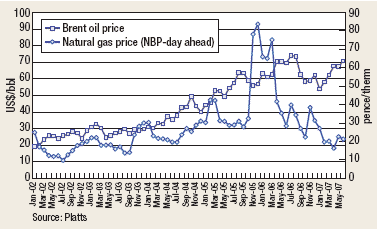 |
Fig.
1. Monthly average oil and gas prices over
the past five years; Brent crude and natural gas (NBP). |
|
Within northwestern Europe, the UK gas
market is the most liquid, but it has also been the most volatile.
The supply-demand balance was particularly tight in late 2005, as
UKCS gas supplies fell and planned new import infrastructure was
not yet online. These factors, combined with a cold winter, resulted
in a gas price spike in November-December.
Supply problems were compounded on March 13, 2006, when a fire closed
the Rough Storage facility. Within a day, gas prices reached over 208p/therm
($37.84/Mcf). However, the winter of 2006 saw a marked reduction in
gas prices. Average day-ahead price for December 2006 was 31p/therm
($6.27/Mcf), compared with 83p/therm ($14.93/Mcf) in December 2005.
During 2006 and 2007, the situation has eased as demand has fallen.
Supply uncertainty has diminished with the commissioning of the Langeled
and BBL pipelines and the Teesport LNG regasification facility, in
addition to a capacity upgrade of the Interconnector UK pipeline. The
drop in gas prices has caused a number of southern North Sea gas development
projects to be put on hold, having a knock-on effect throughout the
industry with many jackup contracts not being renewed. Gas prices should
remain relatively stable in the near future.
UNITED KINGDOM
During 2006, overall activity hit a plateau, and a few categories
began to decline. However, exploration and appraisal drilling has rebounded
in first-half 2007. Operators continue to work feverishly to stem output
declines.
Licensing/deals. In March 2006, the Department
of Trade & Industry
(DTI) had announced that a record 1,409 blocks and partial blocks would
be offered in the 24th Offshore Licensing Round. After a lengthy consultation
period, DTI said last February that it would offer 150 E&P licenses
to 104 companies under the 24th Round. The licenses comprise 246 blocks
and partial blocks. DTI said that 17 firms are new UKCS entrants. Three
blocks in Cardigan Bay and one in the Moray Firth, which are close
to or on Special Areas of Conservation that were applied for in the
24th Round, have been discussed with DTI regarding concerns about dolphins
in or near them. DTI has deferred a decision on whether to award or
not pending further assessment.
Last January, DTI and its partners in PILOT published a new listing
of Fallow Blocks and Discoveries. This Eighth Release adds 49 Fallow
Blocks and 11 Fallow Discoveries. In a significant change to the process,
both blocks and discoveries will be considered fallow after 3 yr (previously
4 yr). Fallow discoveries that have been listed on the website for
2 yr will now be relinquished if there are no plans for significant
activity. Previously, the original licensees retained these.
Since mid-2006, both corporate and asset
activity have remained high in the UK. In August 2006, Venture acquired
the entire share capital of CH4, a value of €224 million (about £153.2 million or
$285 million). In September 2006, Tullow reached an agreement to acquire
Hardman Resources, valued at A$1.47 billion (about £581 million
or $1.081 billion).
Last October, EnCore agreed to acquire
Virgo Oil and Gas and associated companies. In second-half 2006,
Endeavour completed its $414 million acquisition of Talisman Expro.
The deal involves interests in seven producing fields and one discovery.
Together, these assets averaged about 8,800 boed during first-half
2006. In first-half 2007, Elixir Petroleum and Gawler Resources Petroleum
announced a merger. Under the proposal, Elixir shareholders will
represent 52% of the new company, with Gawler’s representing 48%. The proposed company would be
capitalized at £14.4 million ($29.26 million).
Two cross-border asset deals occurred
in second-half 2006. Faroe Petroleum acquired ConocoPhillips’ equity share in Minke and Orca fields
on the UK/Netherlands median line. On the Norwegian border, Lundin
agreed to acquire Total’s interest in Peik field. In March 2007,
Bow Valley acquired an interest in Peik from ExxonMobil for £34.65
million.
In the northern North Sea, Nautical acquired a majority stake in the
Bluebeard and Skipper discoveries from Exmar. To the south, BP agreed
with Chevron to acquire interests in central North Sea blocks containing
the Arundel and Kidd discoveries. In exchange, Chevron will acquire
an additional interest in Alba field.
In the southern North Sea, Granby acquired
ExxonMobil’s interest
in Tristan North West field in Block 49/29b (P105). Mosaic Natural
Resources will acquire the remaining 50% interest in 49/29b. Also in
the Southern Gas basin, Venture sold two interests to North Sea Gas
Partners: a gross 75% stake in Venture’s Ensign discovery and
a 50% farm-out of the forthcoming Amanda appraisal and Agatha exploration
wells.
Antrim Energy last November acquired a
controlling interest in Fyne and Dandy fields from Eni for $8 million.
The firm agreed to pay another $10 million to Eni upon DTI’s approval of a development plan.
BG Group agreed to acquire ConocoPhillips’ stakes in Armada and
Everest fields, in the central North Sea, for $143 million. Dana signed
a $55 million cash agreement with Gaz de France to acquire 25% of Cavendish
gas field in the southern North Sea, boosting Dana’s interest
in the field to 50%.
During fourth-quarter 2006, three major asset packages were offered
for sale. ExxonMobil offered its interests in the Lancelot area, the
Thames area, the Hewett area and the Bacton terminal. Shell offered
its interests in two North Sea asset packages. The first package includes
Strathspey field, plus the Marten, Phoenix and West Wick discoveries,
and a 30% interest in exploration block 21/9. The second package comprises
interests held by Shell and partner ExxonMobil in Blocks 29/1NE, 30/6
and 30/11a (P011). Shell and Esso hold a combined 66.67% interest in
the blocks, with operator Maersk holding the other 33.33%. Talisman
is selling its interests in the Brae Area of the South Viking Graben.
In May 2007, ExxonMobil began offering equity in its Mid-North Sea
High Blocks, in return for funding a part of the cost of exploration
on the Corbenic prospect. Also in May, Shell said it is offering a
100% interest in Clipper South field. Separately, Shell proposes to
divest certain pre-developments from its UK central North Sea portfolio.
The package is a mixture of operated and non-operated blocks held under
licenses from the early rounds, with low rental fees and with all work
commitments fulfilled. Shell wishes to sell the properties as a single
package for cash but will consider offers for individual blocks.
In June 2007, Shell UK and partner Esso
E&P
UK began marketing their interests in various assets in the East
Shetland basin of the northern North Sea. The package includes Cormorant
Alpha (or South), Cormorant North, Eider, Kestrel, Pelican and Tern
fields, all Shell-operated. The companies are also offering non-operated
interests in Hudson and Otter fields. In early July, Shell and ExxonMobil
offered their interests in a number of central North Sea blocks,
all Shell-operated. They lie within quadrants 21, 22, 29 and 30,
and along the western margin of the West Central Graben. They contain
a number of discoveries, while some are purely exploration blocks.
During first-half 2007, Perenco agreed with ExxonMobil to acquire
the shares of its subsidiary, Superior Oil (UK) Limited, and certain
assets of Mobil North Sea Limited in the UK southern North Sea. The
transaction involves a number of producing gas fields, including Arthur,
Excalibur, Galahad, Gawain, Guinevere, Lancelot, Mordred, Hewett, Malory
and the Thames Complex. Perenco will operate all these fields, except
Hewett and the Hewett terminal at Bacton. Average 2007 net production
should be about 95 MMcfd (16,000 boed). In May 2007, after Hess said
it would divest interests in Scott and Telford fields, Premier Oil
completed acquisition of an additional interest in Scott field from
Hess for $52.6 million.
Exploration/appraisal drilling. During 2006, 81 exploration and appraisal
wells were spudded on the UKCS. Compared with the number of wells started
in 2005, this represents a 9% decline. During 2006, 44% of the wells
spudded were exploratory. So far in 2007, there have been 40 exploration
and appraisal wells, a 33% increase vs. the same period last year,
Fig. 2. The number of wells drilled has increased significantly from
previous years, and 2005 levels are the highest since the oil price
crash of 1999. Following a slight drop in 2006, 2007 levels should
exceed those of 2005.
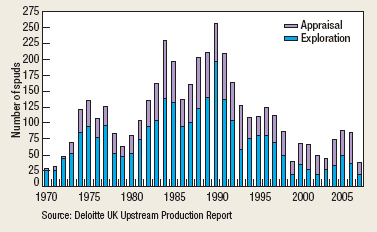 |
Fig.
2. UKCS exploration and appraisal wells drilled
by year (as of June 31, 2007). |
|
Through second-half 2006 and first-half
2007, a number of discoveries were made, and a number of sidetracks
were conducted, with Oilexco once again being very bullish in its
drilling campaign. Figure 3 shows the number of wells drilled in
2006 on the UKCS by company, with Oilexco clearly leading the field.
After an impressive first year as a new entrant in 2004, Oilexco
found itself in fifth place in 2005. Oilexco drilled five sidetracks
on 21/23a-9a to appraise the Sheryl discovery, previously known as
Disraeli, made with well 21/23a-8. Oilexco planned to drill five
separate boreholes at the Sheryl cluster. However, a sixth sidetrack,
21/23a-9U, was tested in September and flowed at a maximum rate of
1,915 bpd of 23°API oil through a 36/64-in. choke
at 334 psi, flowing pressure.
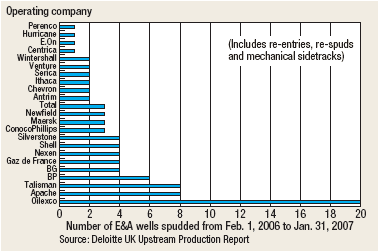 |
Fig.
3. Exploration and appraisal wells drilled
by company on the UKCS (as of Jan. 31, 2007). |
|
Oilexco drilled a well cluster to appraise the Shelley accumulation,
discovered in 1984. Oilexco planned to drill a minimum three-well cluster
but eventually drilled seven sidetracks. The well cluster successfully
defined a broad, low-relief oil-bearing structure. The 22/2b-13T tested
through 42 ft of perforations (18 ft TVD) and flowed at a maximum 3,082
bopd. Two more appraisal wells are planned in 2007 to evaluate apparent
north and south extensions of the structure.
In January 2007, Oilexco’s 15/26b-9 exploration well penetrated
91 ft of net pay from a gross section of 132 ft from the Upper Jurassic
sand of the Kildare prospect. A drill stem test was performed over
a perforated interval of 125 ft in the Upper Jurassic, which flowed
4,216 bopd and 3.1 MMcfgd. In May 2007, Oilexco appraisal well 22/14b-5
made a multiple-zone, light-oil discovery. The well was drilled on
the Huntington prospect to a TD of 13,325 ft. The well saw two intervals
of 98 ft and 58 ft of 42°API sweet crude oil recorded.
ConocoPhillips sidetracked the 30/6-6
well to test the Shoei prospect and made a new discovery. Appraisal
sidetrack 30/6-6Z confirmed a substantial, commercial gas/condensate
accumulation. Partner BG estimates recoverable reserves at 100-275 million bbl. Antrim sidetracked the 211/23d-17
well to evaluate the Causeway accumulation in the East Shetland basin.
The 211/23d-17Z sidetrack was started in July 2006, and a tested zone
flowed at multiple stabilized rates of up to 7,000 bpd of sweet, 32°API
crude. During a second test, the Ness formation in the western fault
block produced at multiple stabilized rates of up to 7,500 bopd.
Total drilled its 3/15-10 exploration well to test the Jura West structure,
northeast of Forvie field, and encountered over 985 ft of good-quality
Brent reservoir, all of which was gas-bearing. Jura West should begin
producing in 2008, via a 3-km tieback to the Forvie North subsea manifold,
which is linked to the Alwyn North NAB platform. A second development
well and a nearby exploration well are planned.
In second-half 2006, Ithaca drilled the
14/18b-15A re-spud to appraise the Athena accumulation. It tested
1,330 bopd from a 143-ft interval and was suspended for future re-entry
as a production well. Based on the test’s success, Ithaca will
seek approval for a field development plan, covering the entire Athena
accumulation, with first oil predicted in late 2008. In May 2007,
Ithaca finished drilling an exploration well on the Basil prospect.
At a vertical depth of 7,300 ft, the well found 47 ft of gross Beatrice
A sand with excellent reservoir properties. Ithaca believes that
the Basil well can produce at up to 5,000 bopd. Based on 3D seismic
mapping incorporating the well results, Ithaca puts in situ resource
at about 15 million bbl, with about 5 million bbl recoverable.
An offshore exploration success ratio graph in Fig. 4, dating back
to 1970, shows the percentage of successful exploration wells drilled
each year. The graph includes all re-entries and geological sidetracks
but does not include re-spuds or mechanical sidetracks. Success, though
varied, has averaged about 35%. Following 2002, the success rate dropped
significantly and remained low through 2005, increasing back up to
around 35% in 2006.
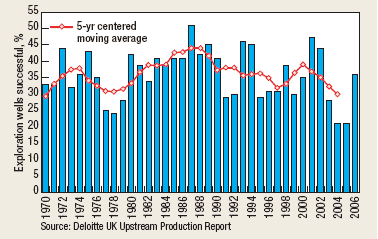 |
Fig.
4. Exploration success by year on UKCS (as
of Jan. 31, 2007). |
|
Development/production. Since July 2006, output has begun from Brenda,
Buzzard, Cavendish, Dumbarton, Merganser, Minke, Nicol, Tethys and
Tweedsmuir fields. Buzzard should add 115,000 bpd to UKCS liquid production
in 2007. UKCS liquid production for 2007 should average around 1.96
million bpd, Fig. 5. Production should continue to decline after 2008.
UKCS gas production for 2007 should average 9.3 Bcfd. The increase
in UKCS gas output since the early 1990s reached a plateau of around
11 Bcfd in 2001. Production levels remained fairly constant through
to 2003, and a steady decline has occurred since then.
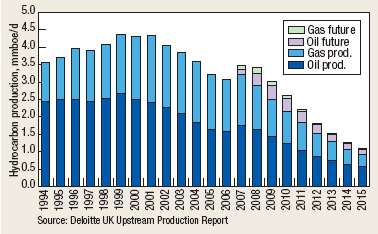 |
Fig.
5. Historic and forecast UKCS production. |
|
Buzzard field contains over 1 billion
bbl of OOIP and is believed to have a 46% minimum recovery factor.
Based on 3D seismic interpretation and advanced mapping techniques,
Nexen increased OOIP by 15% in 2005. In total, 27 producers and 16
water injectors will be drilled in the field’s lifetime. A new 18-in., 28-km oil pipeline to the Forties
pipeline system, for transportation to Cruden Bay, and a new 10-in.,
29-km gas tie-in to the Frigg pipeline have been installed. Fuel gas
will be required in 5-7 yr, and gas will be supplied from the
Frigg system.
Investments during 2006 included drilling and completing eight producers
and six injection wells, and completing and tying in all facilities.
Field production began last January. Five producers and two injectors
are planned for 2007.
NORWAY
As was true last year, Norwegian activity will remain high through
2007 and into 2008. Exploration is mounting a comeback, and additional
development projects are slated.
Licensing/deals. Following the deadline for application to the Awards
in Predefined Areas 2006 (APA 2006) on Sept. 29, 2006, the Ministry
of Petroleum and Energy received applications from 43 companies. The
licensing round opened in February 2006 and comprised 200 blocks or
partial blocks, allowing access to extensive areas in the North, Norwegian
and Barents Seas. In February 2007, Norway awarded 48 production licenses
to 33 companies in the APA 2006. This is the highest number of licenses
ever offered on the Norwegian Continental Shelf (NCS) and represents
85 blocks or partial blocks. On May 31, 2007, the Ministry of Petroleum
and Energy offered an additional 10 production licenses to 22 companies
under the APA 2006, increasing the number of licenses awarded to 58.
Following the APA 2006 awards, Norwegian officials announced the APA
2007. On offer are 221 blocks or partial blocks. Deadline for applications
is noon on Sept. 28, 2007, with license awards being made in late 2007/early
2008. The government also announced that the 20th Licensing Round will
be postponed one year, until 2009, to ensure cost-efficient exploration
of frontier areas on the NCS.
As of Jan. 1, 2007, the government announced
that regulations relating to area fees would change, in an attempt
to ensure that activity would take place in NCS production licenses
that have lain fallow. Under the new rules, no area fee will be paid
for tracts with ongoing E&P,
while areas without activity will pay a higher fee than previously.
The Norwegian Petroleum Directorate (NPD) said the purpose of the amendments
is to encourage licensees to initiate activity in areas that have been
on hold, or to relinquish them to the state, to give other licensees
a chance.
In fourth-quarter 2006, Statoil and Norsk Hydro announced a merger.
The new firm will be called StatoilHydro ASA until its new board of
directors develops a new name and logo. Lundin Petroleum AB announced,
in March 2007, its intention to form a new company called Viking Oil
and Gas ASA from its UK and Norwegian businesses. Viking has been a
wholly owned subsidiary of Lundin, and the parent firm intended to
launch an Initial Public Offering (IPO) of the Viking shares and to
seek a listing on the Oslo Stock Exchange. In May, Lundin withdrew
this offering. Also at corporate level, in June 2007, Dana Petroleum
signed conditional subscription and acquisition agreements for the
shares in Ener.
In third-quarter 2006, in the South Viking
Graben, Ener agreed to acquire Shell’s interest in Jotun field.
In the North Viking Graben, Revus signed an agreement with Bayerngas
to sell its interest in a number of licenses containing the Fram
B accumulation.
During third-quarter 2006, Lundin and
Norwegian Energy Co. (Noreco) agreed to jointly pursue exploration,
development and production opportunities in quadrants 1, 2 and 3.
As part of the agreement, Noreco will carry Lundin’s future
license costs (amounting to $38.5 million) in license PL006C. In
return, Noreco will acquire a 25% interest in license PL006C, which
covers partial Block 2/5c, from Lundin.
Two asset acquisitions were announced
in first-quarter 2007. Bayerngas agreed with DNO to acquire the latter’s interest in Licenses
PL263 and PL263B. Meanwhile, Polskie Górnictwo i Gazownictwo
SA (PGNiG) agreed to purchase an interest in Licenses PL212, PL212B
and PL262, which contain Skarv and Snadd fields, from ExxonMobil. PGNiG
will need to pre-qualify as an NCS licensee and is required to obtain
a gas shipper license.
In second-quarter 2007, Revus Energy sold a 15% interest in License
PL274 to Noreco. The license covers most of Block 1/3 in the East Central
Graben and contains the Oselvar discovery. The company said that the
net resources sold are 5.7 million boe.
In another deal in June, Revus acquired interests held by Statoil
in Licenses PL037C and PL037D, giving Revus 100% interest in both licenses
and the Norwegian part of Murchison field, plus the Delta discovery.
Revus said the deal will increase its reserves and contingent resources
by 2.2 million boe and increase daily production to 3,000 boed from
2,300 boed.
Exploration/appraisal drilling. After several years of decreasing
drilling in Norway, 2006 saw a rise in the number of exploration and
appraisal wells spudded, Fig. 6. There were 29 new wells started, a
107% increase from 2005. Of these, 62% were for exploration. Geographically,
48% of the wells drilled were in the North Sea, with 31% in the Norwegian
Sea and the remaining 21% in the Barents Sea.
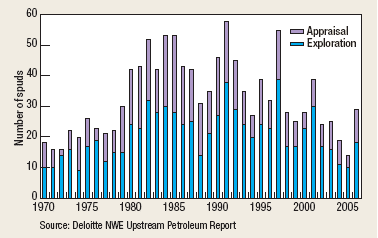 |
Fig.
6. Exploration and appraisal wells drilled
by year in Norway (as of Jan. 31, 2007). |
|
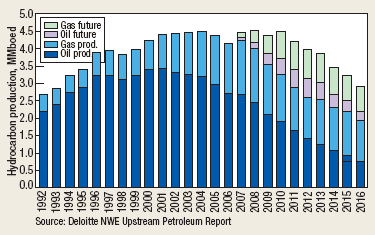 |
Fig.
7. Historic and forecast production in Norway. |
|
Statoil drilled exploration sidetrack
6608/10-11 S from production well 6608/10-K3 H on Norne field. The
well investigated the Jurassic, Fangst and Båt groups in the
Trost prospect, about 1 km west of Norne. The well proved gas in
the Fangst Group. The find is now being evaluated with a view to
production being tied back to Norne.
Statoil drilled appraisal well 6506/11-8 to test the Garn and Ile
formations, and to test for better reservoir qualities in the south
of the Morvin structure. The well confirmed that the oil discovery
extends into the Middle Jurassic.
Eni drilled the 7122/7-4 S appraisal to test the Goliat discovery
and established a deep oil/water contact in the Realgrunnen sub-group
reservoir and a gas/oil contact in the Kobbe formation. In addition,
a deeper oil column was encountered in sandstone in the Klappmys formation
of the early Triassic.
Again, in 2007, Statoil has been very active. On May 29, Statoil announced
a promising oil discovery at its Ermintrude prospect well 15/6-9 S,
about 7 km north of Sleipner field and 3 km east of the 15/5-1 Dagny
discovery in the central North Sea. The well was drilled to a TD of
12,631 ft and was found to contain light oil in mid-Jurassic sandstones.
A small gas find was also proven in Tertiary sandstones. The well will
be permanently plugged and abandoned.
This well was sidetracked twice. The first sidetrack, 15/6-9 A, was
kicked off in late May 2007, to establish whether there is gas/condensate
above the oil found. The 15/6-9 S was drilled to a 12,964-ft TD and
was found to contain light oil. A small gas find was also proven. The
second sidetrack was kicked off in June.
At the end of May, Statoil started drilling exploration well 6507/11-8.
The well is being drilled in the northern part of the Halten Terrace
to test a prospect to the northeast of Midgard field in license PL062.
Talisman’s 15/12-17 S appraisal
was drilled to test the Rev (previously Varg South) accumulation.
Sidetrack 15/12-17 A was started in February and proved additional
gas and condensate reserves. Talisman has suspended the appraisal
well as a potential producer, and the NPD has upgraded its estimate
of recoverable reserves in Rev to about 5 Bcm of gas and 5.03 million
bbl of condensate.
Shell finished drilling appraisal 6406/9-2,
spudded last February, to delimit the Onyx Sørvest discovery made with well 6406/9-1
in 2005. The discovery contains gas. The 6406/9-2 encountered gas/water
contacts, confirming Onyx Sørvest’s northerly extent.
NPD’s preliminary estimate of the discovery’s size is in
the range of 30-50 Bcm of recoverable gas.
Development/production. Average liquids production during 2007 is
expected to be about 2.7 million bpd. Main contributors to this total
are expected to be the Ekofisk complex (11.2%), Grane (7.4%), Troll
Area (7.1%), Oseberg Area (6.5%), Gullfaks (6.4%), Aasgard (7.5%),
Snorre (5.6%), Statfjord Area (6.5%), Kristin (4.8%) and Heidrun (4.8%).
Average gas production for 2007 is expected to be about 256.9 MMcmd.
Of this total, 37.8% is expected to come from Troll East, 11.8% from
the Sleipner Area, 10.98% from Aasgard and 7.7% from Kvitebjoern. Ringhorne
East came onstream in 2006. Ormen Lange, Snoehvit Area, Vilje, Alvheim,
Blane, Enoch and Volve are expected onstream in 2007. Oseberg Delta,
Rev and Tyrihans have been granted development approval.
NETHERLANDS
Thanks to high commodity prices, operators are investing more money
in the Dutch North Sea. The result is more drilling and an end to production
declines.
Licensing/deals. In second-half 2006, a significant number of licenses
were awarded to several companies. A JV of Ascent Resources (90%) and
GTO Limited was awarded four exploration licenses covering 795 km2.
Together they undertook a technical evaluation of the areas, focusing
on the newly recognized Carboniferous exploration plays.
Grove was awarded three offshore exploration
licenses that cover 1,148 km2 and contain a number of significant
Upper Jurassic oil discoveries. The company was also awarded Production
License P/8a, which contains Horizon West oil field. The 15-yr license
covers 26.17 km2. Island announced transfer of Production License
Q/13, offshore the Netherlands. Island will initially hold a 100%
working interest in the license-along
with Nido-which will fall to 60% once the agreement for the mandatory
40% state participation through state firm Energie Beheer Nederland
B.V. (EBN) has been completed.
Total was awarded a 4-yr exploration license
for Block L/3, about 100 km north of Den Helder. EBN is expected
to take a 40% interest. Cirrus Energy, in first-half 2007, was awarded
a production license for offshore Block M1a by the Dutch Mining Council.
The license includes the M1a discovery. The Dutch state will help
develop this field through the award of a 50% working interest to
EBN. In July 2006, Cirrus said it had entered into an agreement to
acquire NAM’s interest in
the M/7 license.
Last November, a major deal was announced
when Abu Dhabi National Energy Co. agreed to purchase BP’s Netherlands-based E&P
business. This grouping comprises onshore and offshore production assets,
including the gas infrastructure business (Piek Gas Installatie) in
Alkmaar. BP operates five offshore licenses (Blocks P/15, P/18) and
one onshore license (Bergen) in the Netherlands. The licenses contain
several mature gas and condensate fields, as well as the suspended
Rijn oil field.
Exploration/appraisal drilling. Ten new wells were spudded in the
Netherlands in 2006. This halts the recent decline in Dutch offshore
drilling and is a 43% rise on the number of spuds in 2005. Half of
the new wells were in the K quadrant, with the rest scattered across
the sector.
In second-half 2006, Wintershall drilled exploration well E/18-6 and
encountered a good-quality reservoir, which, when tested, flowed about
45 MMcgfd. Wintershall also drilled the K/18-8 exploration well, which
tested the gas discovery made in 2005 with well K/18-7. The well found
gas.
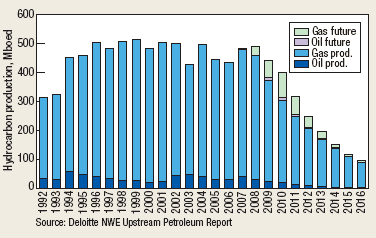 |
Fig.
8. Historic and forecast production in the
Netherlands. |
|
Petro-Canada’s P/10-5 well tested
the Van Brakel prospect and encountered gas. The exploration well
will be re-entered for perforation and testing. In adjacent block
P/11-5, Petro-Canada drilled a wildcat on the ves Nes prospect, 6
km north of the oil- and gas-producing De Ruyter field. The well
encountered gas. Last December, Wintershall drilled exploration well
Q/1-26, near the northwestern edge of Hoorn oil field. At 8,816 ft,
the well lost circulation and was plugged back and sidetracked. A
second sidetrack, Q/1-26 S2, was completed in April.
Development/production. Since 1975, Netherlands
gas production has grown steadily, peaking in 1999 and 2001 at around
77 MMcmd. In 2006, production averaged 67 MMcmd. Production is expected
to rise again to above 70 MMcmd in 2007 and 2008, as new fields come
onstream. Liquid production peaked in 1994 and was followed by a
sharp decline until 2001, when Hanze field began output. Liquid production
in 2006 was about 31,300 bpd. The ‘De Ruyter’ P10a/P11b oil field,
operated by Petro-Canada, went onstream in September 2006, potentially
adding 22,700 bpd to the Dutch sector in 2007. In 2006, the K18b-Kotter
and L16a-Logger fields’ profiles were extended outward to around
2010, due to high oil prices. In first-quarter 2007, BP’s assets
were bought by Taqa Energy BV, which aims to redevelop the P15a-RIJN
field.
DENMARK
Although exploration of late has not been as fruitful as hoped, operators
remain optimistic, and licensing reflects this attitude. Significant
new finds and resulting development are needed to halt further output
declines.
Licensing/deals. In July 2006, Star Energy signed a letter of intent
with Tethys to farm-in on Licenses 1/02 and 1/03. Star will pay 20%
of the historical costs and 40% of the cost of an exploration well
on License 1/02. In doing so, Star will acquire a 20% interest in Licenses
1/02 and 1/03.
Two applications for Danish licenses were
made in the last three months of 2006. The Danish Energy Agency (DEA)
received an application for an E&P license under the Open Door
Procedure from DONG for six blocks in northwestern Jutland. Another
Open Door application was received from Jordan Oil and Gas, which
covers about 480 km2 in onshore Jutland Quadrant 5509.
During first-quarter 2007, the Ministry
of Transport of Energy granted three new Open Door licenses (1/07,
2/07 and 3/07) covering different parts of onshore Jutland, effective
from Feb. 12. The Nordsøfonden
participates in each of the licenses, with a 20% interest, on behalf
of the state.
License 1/07 was applied for in August 2006 by German firm Geo-Center-Nord
GmbH, which holds an interest in a German license to the south of 1/07.
The license covers onshore and offshore blocks 5409/5, 5409/6 and 5409/7,
which are bounded to the south by the German border.
License 2/07 was applied for last September by Jordan Dansk Corp.,
a subsidiary of US-based Jordan Oil and Gas. The license covers 482
km2 in onshore Jutland quadrant 5509. During the Third Licensing Round
in 1989, Jordan won a non-operating interest in license 9/89, which
covered the same area as the tract now under application. The license
was not drilled, and it was relinquished in 1994.
In October 2006, DONG applied for License
3/07. It covers 1,274 km2
in northwestern Jutland and includes Blocks 5608/2, 5608/3, 5608/6,
5608/7, 5608/10 and 5608/11. Last March, DONG agreed to acquire ConocoPhillips
Petroleum International Corp. Denmark, increasing its interest in Licenses
4/98, 5/98 and 1/06, of which it will become operator.
Exploration/appraisal drilling. Four new Danish wells were spudded
in 2006, an increase of 100% on the number started in 2005. The majority
of the wells were drilled for exploration, with one appraisal well
spudded.
In May, Altinex spudded the Nini-5 appraisal, targeting the Nini East
discovery found by the Nini-3 well, about 2 km southwest. In mid-June,
DEA said that DONG had finished drilling Nini-5 and that the results
are considered positive. The well was drilled to 5,882 ft and proved
the presence of oil and a minor amount of gas.
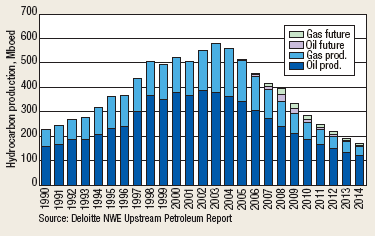 |
Fig.
9.Historic and forecast production in Denmark. |
|
Development/production. By Jan. 1, 2007, a total of 1.878 billion
bbl of oil and 137 Bcm of gas had been produced in Denmark. Liquids
production peaked in 2004 at 388,600 bpd. Gas sales peaked in 2005
at 33.1 MMcmd, due to a significant increase in production from Tyra
field, which acts as a swing producer for Danish production. Danish
gas output entered a steady decline in 2007.
IRELAND
Exploration drilling resumed in 2006, and there were positive results.
Licensing activity remains strong.
Licensing/deals. During August 2006, Noel Dempsey TD, minister for
Communications, Marine and Natural Resources, announced that he was
offering exploration licenses to four consortia under the Slyne Trough
and Donegal basin Licensing Round. The period for applications closed
on March 15, 2006, and the successful applicants were: 1) Statoil (operator)
and Shell; 2) Serica (operator); 3) Island (operator), Lundin and Endeavour;
and 4) Island (operator) and Lundin. Acreage awarded covers about 25,000
km2.
Also in 2006, Providence was awarded, together with partners ExxonMobil
and Sosina, a new Licensing Option, for 15 blocks in the Goban Spur
area off southwestern Ireland.
During first-quarter 2007, the minister for Communications, Marine
and Natural Resources confirmed that he will hold a new licensing round
in 2007, offering exploration licenses in the Porcupine basin. Acreage
on offer will cover unlicensed frontier blocks over about 63,500 km2.
Applications for Frontier Exploration Licenses (FELs) in the round
should be invited until the end of October. Applications may be made
for a maximum three blocks in the north and six blocks in the south
of the basin.
Providence Resources and license partner
Midmar were granted two licenses in first-quarter 2007, Standard
Exploration Licenses (SELs) 1/07 and 2/07. In April 2007, Providence
announced that it had been granted an extension to the term of Licensing
Option 05/3 to Sept. 30, 2007. The license, in St. George’s
Channel, was awarded in May 2005. The Licensing Option contains the
Apollo oil prospect.
Last September, Providence signed a farm-out deal with Challenger,
whereby Challenger acquired a combined 20% interest in Licensing Options
03/1 and 03/8. In return, Challenger paid 26.7% of the costs of the
seismic program in 2006. Thereafter, Challenger will be responsible
for 20% of all future license, drilling and development costs.
In first-quarter 2007, Providence announced two farm-out deals. First,
it agreed to farm out part of its interest in SEL 2/07, In which Dyas
and Atlantic Petroleum will each acquire interests. Second, the company
agreed to farm out part of its interest in FEL 2/04 to Challenger,
a subsidiary of GlobalSantaFe. Forest Gate Resources also received
final approval for its acquisition of an interest in SEL 2/07 from
Providence.
Exploration/appraisal drilling. Three
new wells were drilled in Ireland in 2006, an increase from no wells
in 2005. An exploration well and an appraisal well were drilled in
the Celtic Sea, while the remaining wildcat was in the Donegal basin.
During 2006, Island Oil & Gas
discovered the Old Head of Kinsale accumulation with well 49/23-1.
Well 13/12-1 was drilled by Lundin on
the Inishbeg prospect and is the first well to test the South Donegal
basin’s
potential. The 13/12-1 encountered a lack of reservoir development
and was not tested.
Marathon drilled the 48/23-3 to appraise the Seven Heads West extension.
The well tested dry gas at a combined maximum rate of 31.2 MMcfd from
two separate horizons. The well confirmed the western extension of
the Seven Heads field. Island has suspended 48/23-3 as a potential
gas producer.
The Island-operated 49/23-1 exploration
well targeted the Old Head of Kinsale prospect and struck a gross
100-ft gas column. Initial indications are that the gas extends over
an area in excess of 22 km2 and that the potential gas in place is
likely to be in the range of 90-120
Bcf. In May 2007, Island spudded the 49/23-2 appraisal in the Celtic
Sea. At the end of May, Island announced that this appraisal had encountered
gas. Preliminary results indicated reservoir continuity with the gas
sands encountered in 49/23-1, 3 km to the northeast, reservoir permeability
in line with 49/23-1, and a gas-water contact within 5 ft of that extrapolated
for 49/23-1. This validated the presence of a 100-ft gross gas column
for the Old Head of Kinsale gas field. Sidetrack 49/23-2Z was successfully
tested after reaching a TD of 5,140 ft. The well produced dry gas in
excess of 18 MMcfd, with an absolute open-flow potential of 47 MMcfd.
GREENLAND
During third-quarter 2006, Greenland’s
minister of Housing, Infrastructure and Minerals and Petroleum, Jørgen
Wæver
Johansen, opened the Disko West Licensing Round. It covers areas offshore
West Greenland between 67°N and 71°N. On offer is 92,228 km2
of acreage, divided into eight license blocks of about 8,000-14,000
km2. On Dec. 15, 2006, Greenland’s Bureau of Minerals and Petroleum
announced that Chevron, DONG, ExxonMobil and Husky had submitted a
total of six applications for exploration and exploitation licenses
offshore western Greenland. The second phase of licensing was set start
on Aug. 1, 2007. 
|
THE
AUTHOR |
|
Rhydian
Williams is a manager in the Petroleum Services Group of Deloitte
Touche in London. He leads the northwestern Europe data team
and associated reporting products. Mr. Williams joined Arthur
Andersen in 2000 after earning an MSc degree in petroleum sedimentology
from Reading University. He also holds a BSc degree with honors
in geology from the University of Wales-Aberystwyth.
He joined Deloitte in 2002, when the company acquired the Petroleum
Services Group from Arthur Andersen. |
|












